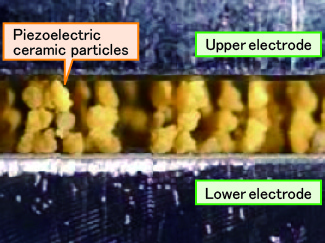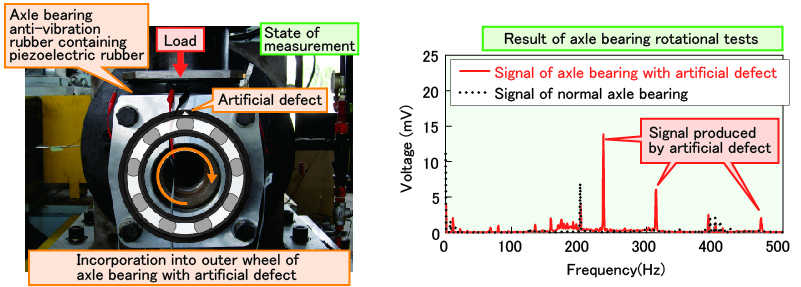4. Improving piezoelectric rubber performance through particle alignment
- A ten-fold increase in the performance of piezoelectric rubber was achieved by improving its manufacturing process.
- The enhanced performance piezoelectric rubber can be used in anti-vibration materials possessing sensor functions, and in sensors to detect axle bearing damage, without the need for an amplifier.
Piezoelectric materials have the property of being able to exchange electrical and mechanical energy reversibly. Therefore they are often used in sensors and actuators etc. Piezoelectric rubber is among these materials and offers the added advantages of being flexible, malleable (not easy to break) and easily shaped. It is can thus be employed widely, although traditional piezoelectric rubber presents the drawback of having low piezoelectric performance - only about one tenth of other piezoelectric materials.
Consequently, the piezoelectric rubber manufacturing process was examined, revealing that the piezoelectric performance of the rubber could be improved by aligning the piezoceramic particles incorporated into the material during manufacturing. Moreover by optimizing the modulus of elasticity of the rubber, the piezoelectric ceramic particle size and the electric field density etc., applied during the manufacturing process, it was possible to increase the d-constant (the electric load produced per unit of energy when pressure is applied to the piezoelectric material) by a factor of 10. For a sensor, this value is more than sufficient, and there is no more need for an amplifier, making it possible to use the material as a low power sensor (table 1). Furthermore because of the low number of piezoelectric ceramic particles, the young's modulus is low and thus the piezoelectric rubber can also be used as anti-vibration material. As an example of how this piezoelectric rubber can be employed, it was incorporated into the anti-vibration rubber of an axle and tested. Results demonstrated that even without an amplifier, the rubber maintained its anti-vibration function and was effective in detecting axle damage (Fig. 2).

Fig.1 State of particle alignment- Table 1 Comparison of material characteristics


Fig.2 Example of newly developed piezoelectric rubber in a sensor with anti-vibration properties
for detecting axle bearing damage